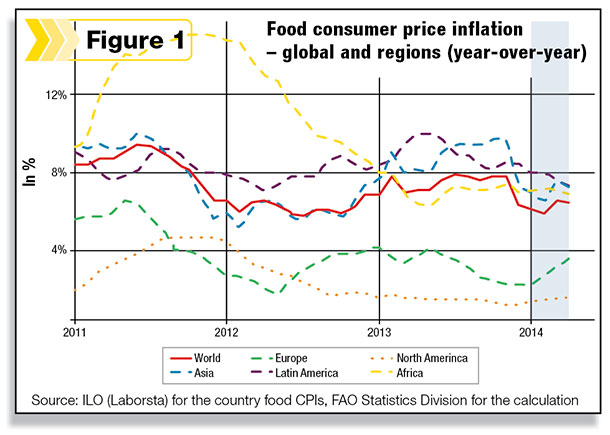And yet we’re not even close to the levels seen in other countries. Food inflation is bumping upward in the U.S. but still drastically lower than what’s seen globally.
That’s the conclusion of a couple of recent studies, including one from the Food and Agriculture Organization (FAO) of the United Nations. FAO reports the world average of food inflation was around 7.4 percent heading into 2014. Asia, Africa and Latin America were all around 8 percent.

Meanwhile, in North American regions the food inflation holds at levels around 2 percent – even lower than surges in Europe. (Figure 1.)
This trend isn’t really news. Food inflation is relatively unheard of in the American breadbasket. The biggest critics of American food production take aim at the quality of our food, not the quantity.
But those criticisms also fall short when you read through the 2014 Oxfam Global Food Index study, which rated the U.S. in the highest categories – not only for affordable food and having enough food, but also for food quality. Among 125 countries measured, the U.S. came in 21st with its only low marks coming from diabetes and obesity.
Using that criteria, the problem isn’t low-quality food in America. It’s low-quality lifestyle habits and low discipline at the dinner table.
Then there are those consumers expressing a demand for higher-quality food products in the form of organic and all-natural production, free of hormones or antibiotics, and promoting that increasingly glamorous term of sustainable.
If that’s what they want, then American producers are going to provide it to them. Perhaps it will require more land, water and production time, but if the demand is there, the farmer and rancher can definitely produce it.
The real question is whether the consumer is willing to pay for it. Or will they abandon American production and find cheaper goods overseas. (Yes, I mean you, Chipotle.)
The investment of time, method and inputs will come at a higher cost for the consumer. Whether it’s at the local grocer’s butcher department or the fast-food chain’s value menu, buyers demanding food – especially beef – must awaken to the reality that food should cost a little more.
That’s the truth, and farmers and ranchers probably should stop feeling bad about defending it. ![]()

David Cooper
Editor
Progressive Cattleman magazine








